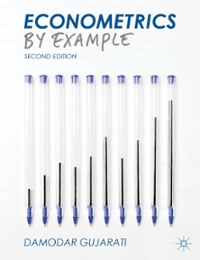Question
It is exactly 24 hours before Jennifer's exams and she is going to spend the entire time studying. She has an Economics exam followed directly
It is exactly 24 hours before Jennifer's exams and she is going to spend the entire time studying. She has an Economics exam followed directly by a Philosophy exam, with no time to study in between. Jennifer's utility is represented by
U(e, b) = e2 b
where e is the score on the Economics exam and bis the score on the biochemistry exam. Jennifer wants to be an economist, so she places more weight on her Economics exam score - it has a higher exponent in her utility function, 2 instead of 1.
Although Jennifer cares more about Economics, she is better at Biochemistry. Specifically, for each hour spent studying Biochemistry, she will increase her score by 5 points, but her Economics score will only increase by 3 points for every hour spent studying Economics. Before studying, she starts at a score of O for each test.
(a) We often write budget equations in the form
Pxx+ PYY M
with Px, py indicating prices of goods X and Y; x, y indicating quantities of those goods; and M indicating the total budget to be spent. What is the budget equation for this problem?
Say Jennifer will spend hE hours studying economics and hB hours studying biochemistry out of her 24 total hours.
1. Write out the budget equation describing the possible values of hEand hBthat Jennifer can choose.
2. Explain what it means that the "prices" of hEand hB - the coefficients in front of them - are both equal to 1 in this equation.
(b) We can also write Jennifer's budget equation in terms of test scores rather than hours.
1. Rewrite a budget equation from the previous question in terms of e and b (instead of hE and hB ) by plugging in the relationships e = 3hE and b = 5hB .
Once again, we can think of the coefficients in front of e and b as representing "prices", PE and PB Reinterpret each price in economic terms: it "costs" Jennfier [some amount] of [something] in order to get [some other amount] of [something else].
( c) Given some number of points e on Economics and b on biochemistry, calculate Jennifer's marginal utility from additional points on each exam. That is, calculate MUE= (e, b) and MUB = (e, b), expressing both as a general function of e and b.
Next, put these two formulas together to calculate the Marginal Rate of Substitution of Economics points for biochemistrypoints (e for b, i.e., treating e as the x variable and b as the y variable).
What would Jennifer's MRS be if she were scoring e = 30 and b = 30? What if she were scoring e = 30 and b = 10? Give meaningful interpretations of both of these numbers.
(d) Put together the prices from part (b) and the Marginal Utility numbers from part (c) into a bang-for-the-buck equation of the form Mux px = Muy py. (Simplify the PX PY equation as much as you can.)
In words, what would it mean if Jennifer were choosing an outcome withe and b such that the marginal utility divided by the "price" of Economics points were higher than that for Biochemistry? What mistake would she be making?
(e) Now combine the budget equation of part (b) with the bang-for-the-buck equation of part ( d) to figure out what test scores Jennifer will get based on her preferred allocation of studying. That is, what e and b will she choose?
(f) Based on the answer to the previous part, how many hours will Jennifer spend studying economics? How many hours will she study biochemistry?
Step by Step Solution
There are 3 Steps involved in it
Step: 1

Get Instant Access to Expert-Tailored Solutions
See step-by-step solutions with expert insights and AI powered tools for academic success
Step: 2

Step: 3

Ace Your Homework with AI
Get the answers you need in no time with our AI-driven, step-by-step assistance
Get Started


